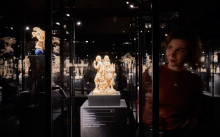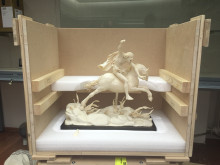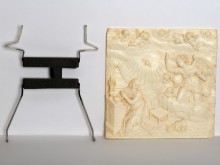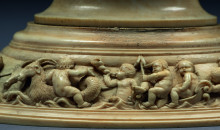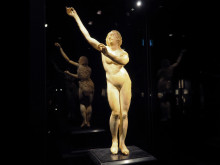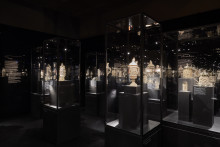It was a hot summer day in July 2018 when the Liebieghaus experienced a unique and magnificent moment in its history: the Reiner Winkler collection and the chairman of the Städel Board of Trustees, Prof Nikolaus Schweickart, signed an agreement on the transfer of the Winkler collection of more than 200 works of ivory to the Städel holdings for display in the Liebieghaus, for the most part in the form of a gift. Reiner Winkler had already considered this step some twenty years earlier, and now the time had come. Shortly after the signing of the contract, it was decided to present the collection to the public in the spring of 2019 in an exhibition entitled “White Wedding. The Reiner Winkler Ivory Collection Now at the Liebieghaus—Forever.”.
This gave us only about one third of the usual time it takes to prepare for an exhibition. We were aware that the scheduling would be tight for both the presentation of the objects and the punctual production of the catalogue. It would be possible only with the teamwork of the entire Liebieghaus and Städel staff.
To begin with, the approximately 190 works in the collection had to be transported from the Reiner Winkler collection room to the Liebieghaus. To this end, transport crates had already been made that would guarantee the protection of the ivories, which are sensitive to both climatic conditions and tremors. For the more compact and stable ivory carvings, so-called “form beds” were tailormade from special foamed plastic. More fragile works, such as the centrepiece of the collection—the “Fury on a Charging Horse”—, could be secured in their crates with padded mountings only at isolated points on their surfaces. The packing of such delicate artworks as these is extremely labour-intensive and time consuming. It took three employees about a week to pack all of the ivory objects properly.
The objects arrived at the Liebieghaus safe and sound and were immediately taken to the storage depot. The days that followed were full of excitement as we unpacked the works, held them in our hands, discovering one grandiose composition or breath-taking detail after another. The intensity of this experience would prove to be typical of the months until their installation in the show. Sometimes when stress once again threatened to get out of hand, I would go to the depot to look at the artworks—now the portraits and combination figures, now objects with biblical or ancient themes, now vessels, works by various artist families or from various artistic milieus—and then go back to my duties with renewed vigour. The planning for the later mounting in the display cases began: for every object, a specialist produced a precisely fitted mount.
During the transport and the preparations for the objects’ mounting, we also had to design the exhibition and the catalogue: time was flying. Rather than a scholarly publication, we undertook to produce a kind of “luxury volume”. This meant that, apart from the catalogue texts, it was equally important to carry out the necessary photography. In collaboration with the photographer Horst Ziegenfusz, we gradually felt our way towards a special mode of capturing these grandiose works. Our concern was not with mundane, matter-of-fact documentation, but with bringing out each object’s unique qualities—the drama the distinguishes them, the emotionality, the grace, the detail—, to “illuminate” them in the truest sense of the word. Once again, each relief, each statuette, each vessel came before our eyes one at a time, demanding to be contemplated with care so as to determine the angle from which it could best be photographed. And again we discovered details that surprised and fascinated us.
One such detail was the little fishes on a covered pitcher by Balthasar Grießmann. This object features a small putti frieze less than an inch high, depicting putti at play in water and hunting. On a tiny spear, one of them has lanced fishes, which, themselves only about two millimetres in length, exhibit tiny incisions representing scales. The collection is so full of dramatic, enchanting and gripping details that it was sometimes difficult to make a selection for the catalogue.
Meanwhile, the architect team BachDolder was already hard at work on the exhibition architecture, for which it was necessary to redesign several of the Liebieghaus’s rooms. And Harald Theiss, Head of the Department of Art Technology and Conservation – Sculpture up to 1800, and his assistant Miguel González de Quevedo Ibáñez were cleaning several of the pieces to optimise their appearance. As late as three days before the opening, they were still removing dust from the nooks and crannies in the ivory surface of Eve by the Master of the Furies. Now she welcomes the visitors as a figure of radiant beauty with a gesture that can be understood as an invitation. And we, for our part, would like to invite you to take a look at her back with its abundant cascade of hair.
The catalogue and brochure were finally printed and the display cases installed. The splendid works of ivory took their places. It was another suspenseful moment: Would the objects show to best advantage as we had envisioned them? Were the display cases as we had ordered them? Would the works look well together, or would we have to reposition some of them?
Two weeks remained until the opening. For the mounting of 190 objects, also including works already formerly in the Liebieghaus collection, the time was tight, especially in view of the fact that several days had been set aside for finetuning the illumination. Yet even now, we were filled with admiration again and again and kept discovering new details. These weeks were extremely strenuous—and extremely exhilarating.
The 26th of March 2019 arrived, and with it the exhibition opening. The collector Reiner Winkler and his daughter Dr Annette Winkler came in the morning and accompanied us throughout the event. It was a momentous day in the history of the museum and the most important in my professional life.



